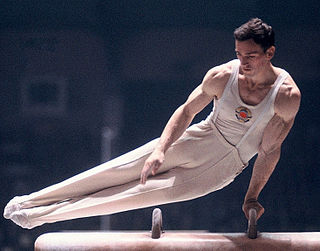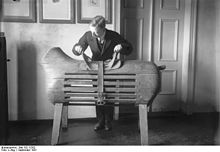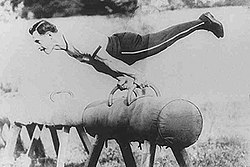
Gymnastics is a type of sport that includes physical exercises requiring balance, strength, flexibility, agility, coordination, artistry and endurance. The movements involved in gymnastics contribute to the development of the arms, legs, shoulders, back, chest, and abdominal muscle groups. Gymnastics evolved from exercises used by the ancient Greeks that included skills for mounting and dismounting a horse, and from circus performance skills.

The vault is an artistic gymnastics apparatus which gymnasts perform on, as well as the skill performed using that apparatus. Vaulting is also the action of performing a vault. Both male and female gymnasts perform the vault. The English abbreviation for the event in gymnastics scoring is VT.

The balance beam is a rectangular artistic gymnastics apparatus and an event performed using the apparatus. Both the apparatus and the event are sometimes simply referred to as "beam". The English abbreviation for the event in gymnastics scoring is BB. The beam is a small, thin beam which is typically raised from the floor on a leg or stand at both ends. The balance beam is only performed competitively by female gymnasts. Beams are usually covered with leather-like material and are only four inches wide.

The rings, also known as still rings, is an artistic gymnastics apparatus and the event that uses it. It is traditionally used only by male gymnasts, due to its extreme upper body strength requirements. Gymnasts often wear ring grips while performing.

Parallel bars are floor apparatus consisting of two wooden bars slightly over 3.4 metres (11 ft) long and positioned at roughly head height. Parallel bars are used in artistic gymnastics and also for physical therapy and home exercise. Gymnasts may optionally wear grips when performing a routine on the parallel bars, although this is uncommon.

The uneven bars or asymmetric bars is an artistic gymnastics apparatus. It is made of a steel frame. The bars are made of fiberglass with wood coating, or less commonly wood. The English abbreviation for the event in gymnastics scoring is UB or AB, and the apparatus and event are often referred to simply as "bars". The bars are placed at different heights and widths, allowing the gymnast to transition from bar to bar. A gymnast usually adds white chalk to the hands so that they can grip the bar better.
Artistic gymnastics is a discipline of gymnastics in which athletes perform short routines on different apparatuses. The sport is governed by the Fédération Internationale de Gymnastique (FIG), which assigns the Code of Points used to score performances and regulates all aspects of elite international competition. Within individual countries, gymnastics is regulated by national federations such as British Gymnastics and USA Gymnastics. Artistic gymnastics is a popular spectator sport at many competitions, including the Summer Olympic Games.

Marius Daniel Urzică is a Romanian gymnast. Urzică is an Olympic champion, a three-time world champion and a three-time European champion on pommel horse. He competed at three Olympic Games, medaling each time on pommel horse and contributed to the team bronze in Athens 2004. His unique technique and style of performance have won him the recognition as one of the greatest masters on this piece of apparatus ever, together with Miroslav Cerar and Zoltán Magyar. Known as "The King of the Pommels" in 2001 he achieved the maximum score of 10.00 on this piece of apparatus at the Glasgow Grand Prix. Two elements in artistic gymnastics, one on pommel horse and one on parallel bars are named after him.

The men's pommel horse was a gymnastics event contested as part of the Gymnastics at the 1964 Summer Olympics programme at the Tokyo Metropolitan Gymnasium. The event was held on 18, 20, and 22 October. There were 128 competitors from 29 nations, with nations in the team competition having up to 6 gymnasts and other nations entering up to 3 gymnasts. The event was won by Miroslav Cerar of Yugoslavia, the nation's first medal in the pommel horse. Silver went to Shuji Tsurumi of Japan, the third man to win multiple medals in the event. Yury Tsapenko of the Soviet Union took bronze, breaking a three-Games gold medal streak for the Soviets.

Louis Antoine Smith MBE is a retired British artistic gymnast.
This is a general glossary of the terms used in the sport of gymnastics.

Daniel Ryan Keatings is a retired British artistic gymnast representing Scotland and Great Britain. Both an all-around gymnast and a specialist pommel horse worker, Keatings was the first male British gymnast to medal at the all-around competition at the World Championships, and the first male British gymnast to become a European champion, winning on pommel horse, his signature piece, in 2010 in Birmingham and again in 2013 in Moscow. In 2014, he won gold at the Commonwealth Games, again in pommel horse, for Scotland. With Louis Smith, Max Whitlock and Joe Fraser of England and Great Britain, and Rhys McClenaghan of Northern Ireland and Ireland, Keatings formed part of a golden generation of home nations pommel horse workers who dominated the apparatus at global, continental and Commonwealth Games level from 2010 onwards.

Kōhei Uchimura is a retired Japanese artistic gymnast. He is a seven-time Olympic medalist, winning three golds and four silvers, and a 21-time World medalist.

The men's pommel horse competition was one of eight events for male competitors in artistic gymnastics at the 1968 Summer Olympics in Mexico City. The event was held from 22 to 26 October at the Auditorio Nacional. There were 115 competitors from 27 nations, with nations in the team competition having up to 6 gymnasts and other nations entering up to 3 gymnasts. The event was won by Miroslav Cerar of Yugoslavia, the second man to successfully defend an Olympic pommel horse title. Olli Laiho of Finland took silver, while Mikhail Voronin of the Soviet Union finished with bronze. Japan's three-Games podium streak in the event ended, while the Soviet streak stretched to five Games.

Max Antony Whitlock is a British artistic gymnast. With fourteen medals and six titles in Olympic and World Championships, Whitlock is the most successful gymnast in British history. He is also the most successful pommel horse worker in Olympic Games history, with two gold medals and one bronze.

The men's pommel horse competition at the 2012 Olympic Games was held at the North Greenwich Arena on 28 July and 5 August. It included 69 competitors from 32 nations.

The men's pommel horse competition at the 2016 Summer Olympics was held at the HSBC Arena on 6 and 14 August. There were 71 competitors from 36 nations. The event was won by Max Whitlock of Great Britain, the nation's first gold medal in the men's pommel horse. The nation finished 1–2 in the event, with Louis Smith repeating as silver medalist. It was the first time any nation had earned the top two spots in the event since the Soviet Union swept the medals in 1952. Smith was the second man to win three medals in the event, while Whitlock was the 11th to win two medals.

Rhys Joshua McClenaghan is a Northern Irish artistic gymnast competing internationally for both Ireland and Northern Ireland. He is a double world champion on pommel horse, having won gold in 2022 and 2023, the first Irish artistic gymnast ever to win world championship gold. In 2019, he became the first Irish gymnast to qualify to a world championships final and to also win a medal, taking bronze on pommel horse.

The men's pommel horse competition at the 1936 Summer Olympics was held at the Waldbühne on 10 and 11 August. It was the sixth appearance of the event. There were 110 competitors from 14 nations, with each nation sending a team of up to 8 men. The event was won by Konrad Frey of Germany, the nation's first victory in the event and first medal since 1896. Switzerland earned the other two medals, with Eugen Mack getting silver and Albert Bachmann receiving bronze.

The pommel horse is an artistic gymnastics event held at the Summer Olympics. The event was first held for men at the first modern Olympics in 1896. It was held again in 1904, but not in 1900, 1908, 1912, or 1920 when no apparatus events were awarded medals. The pommel horse was one of the components of the men's artistic individual all-around in 1900, however. The men's pommel horse returned as a medal event in 1924 and has been held every Games since. Pommel horse scores were included in the individual all-around for 1924 and 1928, with no separate apparatus final. In 1932, the pommel horse was entirely separate from the all-around. From 1936 to 1956, there were again no separate apparatus finals with the pommel horse scores used in the all-around. Beginning in 1960, there were separate apparatus finals.




















